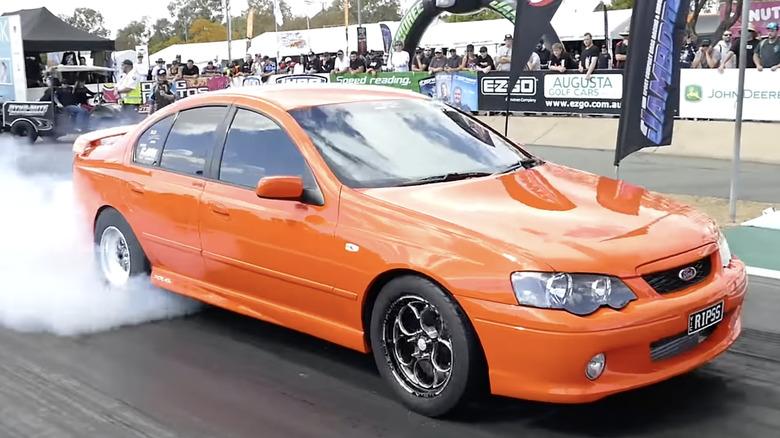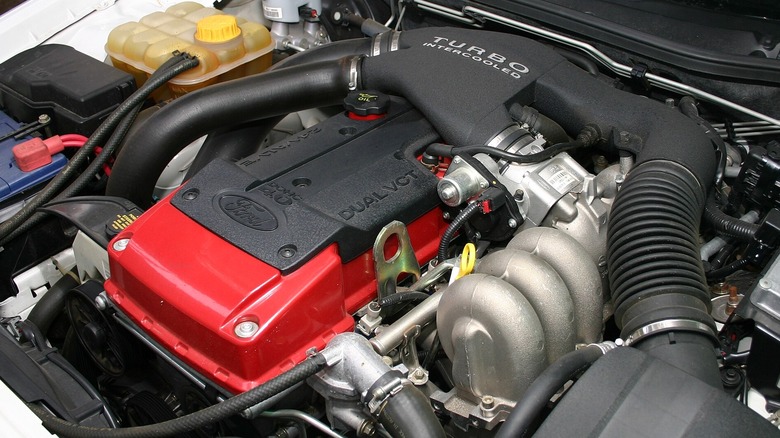Ford's Aussie Engine That Turned Heads: The Barra
When you really consider it, naming automobiles after fish isn't exactly uncommon. There's the Plymouth Barracuda, AMC Marlin, and the Corvette Stingray, among others. Today, let's take a look at an engine named after a fish — the Ford Barra. Barra is a shortened version of Barramundi, an Asian sea bass that's a prized food fish in the Barra's home country of Australia.
In the early 2000s, Ford engineers were tasked with creating an updated alternative to the 4.0-liter inline-six cylinder powerplant, which had propelled its popular Falcon model since the 1980s. A choice was made to retain the iron engine block and bottom-end components mostly as-is. The big news was in the Barra's aluminum cylinder head, which sported dual camshafts versus the old Falcon's single overhead cam, as well as variable camshaft timing and four valves per cylinder. In naturally aspirated form, the Barra cranked out 244 to 261 horsepower and 282 to 288 pounds of torque, depending on the model year.
Coinciding with the debut of the naturally-aspirated Barra in 2002, a turbocharged version was also made available, which is where most gearheads will place their focus. As a testament to the strength of the Barra's internal components, the turbocharged engine didn't make any special provisions for the added boost, such as a forged crankshaft, or forged pistons. Still, it did have a slightly lower compression ratio, a racy red rocker valve cover, and an intercooler to lower the temperature of the intake charge. In stock form, the turbocharged Barra was rated at 322 to 436 horsepower and 332 to 425 pounds of torque.
2,000+ horsepower is possible
In 2013, Ford Australia announced that Barra was living on borrowed time, along with the two cars — Ford's Falcon and Territory — that it powered. Indeed, by autumn 2016, the Barra was no more. In comments to the press, Ford Australia president Bob Graziano cites high labor costs as the reason for the discontinuation, stating, "Our costs are double that of Europe and nearly four times Ford in Asia" and that "our locally-made products continue to be unprofitable while our imported products are profitable."
Unlike Toyota's famous 2JZ inline-six-cylinder that was sold worldwide, the Barra was only produced for the Australia and New Zealand markets, so support for these stout engines mainly exists only in that region. Not only is the aftermarket providing a massive selection of performance parts, but kits are available to swap the Barra into various vehicles, including General Motors subsidiary company Holden.
With a larger turbocharger and a bespoke tuning program, the Barra can easily be cultivated up to 800 horsepower — and that's with stock internal components. With stronger forged internals, the sky is the limit. Using methanol as a fuel, Australian drag racer Maria Passo recently coaxed 2,048 horsepower from a Barra in her street-legal Ford Falcon XR6.
Interestingly, Ford Australia tried to capitalize on Barra's considerable hype by marketing a V8 engine as part of the same family. However, since there was nothing particularly special about the 5.4-liter V8 engine manufactured in Canada and eight-cylinder engines carry potentially higher annual registration fees in Australia, the Barra V8 never gained traction.

